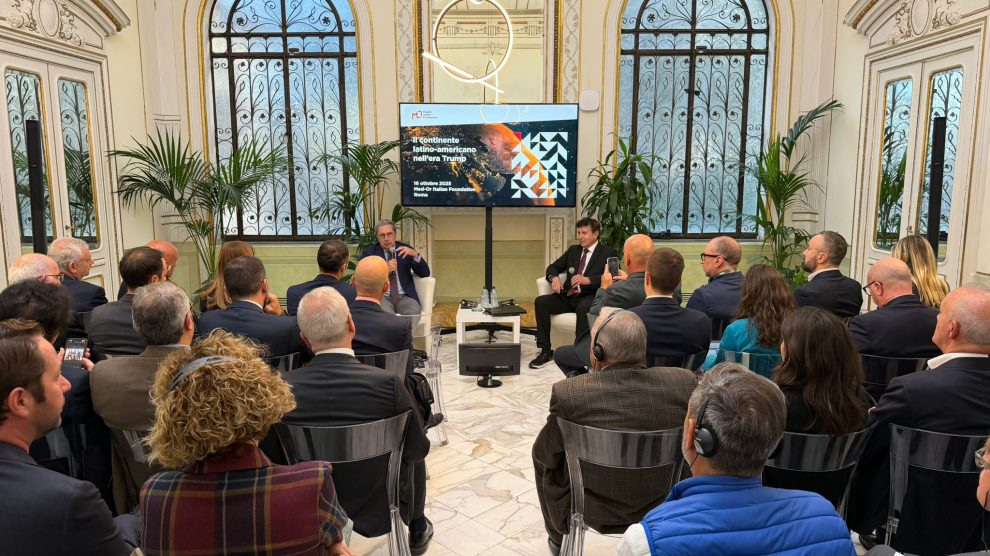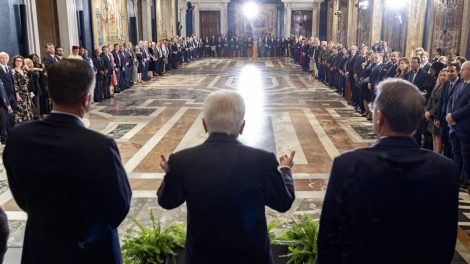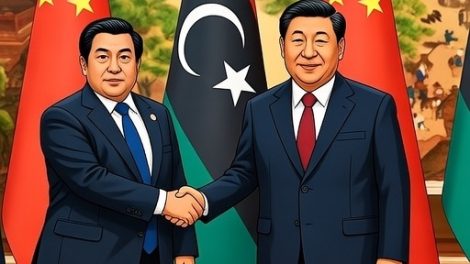Latin America is once again at the heart of geopolitical competition. In the Trump 2.0 era, the region is reemerging as a battleground between global powers — chiefly Washington and Beijing — while Europe and Italy remain on the sidelines, yet with strategic potential.
Happened in Rome: The event “Latin America in the Trump Era” was hosted on October 16 at the Med-Or Foundation.
- San Martín Arzabe was interviewed by Andrea Bairati, president of the Italian Association for Industrial Research (AIRI).
By the Numbers: The new Latin American geoeconomy
- 668 million inhabitants, equal to 8.1% of the world’s population.
- Aggregate GDP: $4.5 trillion, or 5.6% of global output.
- 2025 growth forecast: +2.2%.
- Since 2020, 10 presidents have faced legal proceedings, five between June 2024 and September 2025.
- Only 52% of citizens believe democracy is the correct form of government.
- In many countries, tolerance for using armed forces as internal stabilisers is growing.
From American hegemony to U.S.-China competition. In 2000, the entire continent was within the U.S. economic and political orbit.
- Today, the map has flipped: China is now the top trading partner for most Latin American nations.
- Examples:
- Brazil → $106 billion in exports to China, only $37 billion to the U.S.
- Chile and Brazil → trade surplus with China, deficit with Washington.
- Mexico → the reverse.
- Colombia and Argentina → double vulnerability.
- Europe — and Italy in particular — still play a limited role, relevant mainly in Argentina, where Italy ranks among the top import partners ($2–3 billion annually).
The bioceanic corridor as a paradigm. A key example of the new Latin American geoeconomy is the Brazil–Peru Bioceanic Corridor, a railway connecting Chancay (Peru) and Ilhéus (Brazil), backed by Chinese capital.
- Goal: reduce dependence on the Panama Canal.
- The Chinese-owned port of Chancay is viewed as a dual-use facility, potentially hosting PLA Pacific Fleet units.
- It symbolises the shift, as San Martín put it, “from checkers to chess” — less tactical, more strategic thinking.
- “The old world is not yet dead, and the new one has not yet been born,” he said.
- “Geopolitics is back. And geoeconomics has become the tool to avoid direct military confrontation.”
Actors and influence:
- United States: selective trade reforms, focus on security and migration, AI and cybersecurity development, and new oil and gas deals.
- China: infrastructure and energy investments, diplomatic and technological expansion (5G, smart cities), control over critical materials.
- European Union: sustainable cooperation deals (e.g., Mercosur), digital standards, human rights, and decarbonization.
- Russia: more minor but notable presence — arms, security cooperation, and industrial projects linked to Bolivia’s massive lithium reserves.
Politically, San Martín distinguished liberal democracies (progressive or conservative) from authoritarian regimes such as Venezuela and Nicaragua, where a U.S. military intervention remains unlikely.
- He said the real struggle is over the attractiveness of democratic systems, a dynamic echoed in Africa and Southeast Asia.
- Washington’s response mixes diplomatic and commercial pressure, covert operations in Venezuela, and a $20 billion loan to Argentina, conditioned on loosening ties with Beijing.
Watching from Italy. Historical and cultural ties — and a modest business presence — remain Italy’s foothold in the region.
- But in an environment marked by instability and polarisation, new tools are needed.
- San Martín urged companies to:
- strengthen anticipatory analysis (political intelligence, risk monitoring, disruptive trends);
- include governability among decision-making parameters, not just financial metrics;
- invest in social legitimacy, local human capital, and climate resilience;
- pursue long-term agendas anchored to local development.
A “Mattei Plan” for Latin America?. “Why not a similar approach in Latin America?” asked San Martin Azarbe. “Italy holds cultural and relational capital that could anchor a stable presence — if it manages to align geopolitical, economic, and industrial tools.”
The takeaway: Latin America stands at a turning point:
- The rules of the game are changing, economic ties are becoming geopolitical levers,
- Italy faces a double opportunity: to strengthen its economic footprint and help shape a new balance between democracy, stability, and sustainable growth.





